
Nicolette Teo (b. 1994) is an artist/curator who has received a BA (Hons) Fine Arts from LASALLE College of Art in 2017. Her work delves into finding ways to deal with problems. Stemming mainly from anxiety and the state of worrying, she creates situations that generate instances of calmness. Her practice locates and creates different methods of coping with problematic scenarios and emotional imbalances. She has curated shows such as Head spinning, loop creating at the D/SINI ‘Breaking Waves' Showcase and TCC x LASALLE Art Moves III in 2018.
Eugene TYZ generally makes work that deals with mortality, memory and image making through digital mediums. His current interests reside in examining contemporary grave spaces and understanding the way people think about death in today’s modern societies. He is also interested in exploring the medium of the Internet as a site for memory, storytelling and aesthetic experiences.
As something that permeates our everyday life, the Internet is not something that would come to mind as a medium for art. Yet Internet art, or net art, was making waves in the art world as early as the 1970’s. Flash forward, and we have [ frame + ]. [ frame +] is an independently coded and organised online exhibition that features the works of Denise Yap, Eugene TYZ, Goh Abigail, Nicolette Teo, See Kian Wee, Tristan Lim and Yeyoon Avis Ann. In this conversation, we speak with the exhibition’s curators, Nicolette Teo and Eugene TYZ, about the importance of texts in conceptualising this show, and their thoughts on how Internet art has and will continue to develop in the context of Singapore. Nicolette and Eugene also curated a playlist to accompany our April Issue.

¹ Remediation, Jay David Bolter and Richard Grusin
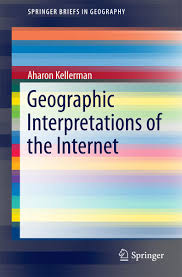
² Geographic Interpretations of the Internet, Aharon Kellerman
Ahead of our conversation, you both picked out three texts that were influential to the process of putting [ frame + ] together. Specifically, you both picked out Jay David Bolter and Richard Grusin’s Remediation, a chapter from Aharon Kellerman’s book Geographic Interpretations of the Internet, and Christiane Paul’s Flexible Contexts, Democratic Filtering and Computer-aided Curating.
As curators, how do you engage with texts when working on an exhibition such as [ frame + ], and how did you see these texts seeping into the curation of the show?
Eugene (E): We approached this project as artists, so we were very interested in working with the material at hand. One of the books we picked out, Remediation, explored developments in new media and provided new ways of understanding new media. It also discussed the logic of immediacy and hypermediacy. With immediacy, there is a contact point between the subject and the medium. For example, light touches the subject and is reflected onto the film in photography. A key aspect of immediacy is the sense of being present in the reality of the subject. On the other hand, hyper-immediacy hypermediacy is about the tension between the mediated subject and the medium. A good example of this are photo collages, where the viewer oscillates between looking through the pieces of photographs, and looking at the photographs themselves.
Because of these texts, we began approaching exhibitions as hypermediated experiences. In an exhibition, a viewer would usually get things such as wall texts, a floor plan, artwork labels and the artworks themselves. It got us thinking about the different parts of putting up an exhibition, and how this could be translated into the context of the Internet.
Nicolette (N): We held onto these texts we picked out as reminders throughout the process of putting this exhibition together.
When Eugene spoke about using text within the space itself, it brought to mind something that a viewer said to me after viewing the exhibition. He thought that there was too much text in the beginning of the exhibition, so he just skimmed through that quite quickly. Within the context of a physical exhibition, you'd usually spend some time with wall text before going on to see the works. There wasn't much text to begin with, and we tried to play around with spacing and images with our exhibition text. Somehow, it still seemed a little too wordy for certain viewers. We still feel that text is necessary in terms of elucidating certain concepts to viewers, but viewers have a different notion of how much text is too much when they see an exhibition in person or online. That was really interesting for us to note.

³ Curating Immateriality, edited by Joasia Krysa
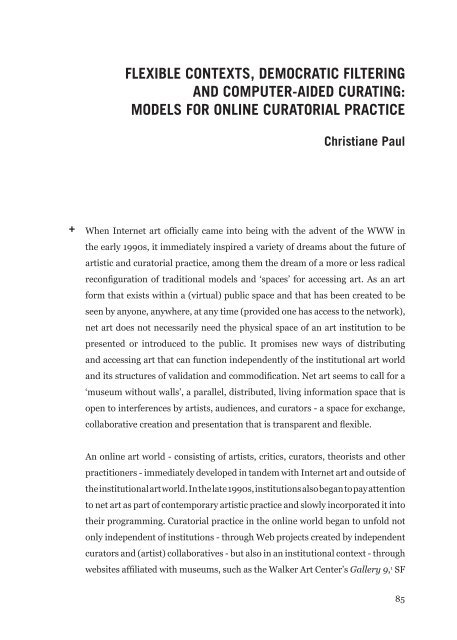
⁴ Flexible Contexts,Democratic Filtering and Computer-Aided Curating, Christiane Paul
Viewers definitely occupy different headspaces when they approach art online versus in person, and so what you said about viewers skimming through text seems emblematic of our wider relationship to the Internet. When you spoke about the different aspects of putting a physical exhibition together, did you find that certain curatorial devices translated better into the context of an online exhibition than others?
E: When putting [ frame +] together, we were quite adamant that this wasn't just a simulated three-dimensional space. We wanted to stay true to the material at hand — which was the webpage itself. We encounter things on the Internet via two-dimensional screen surfaces anyway, but we encouraged the artist to interpret the space they were given any way they wanted to. Each artist started with a single webpage to occupy, and they were free to expand their works into other webpages if they wanted to.
Something that I found different between putting on a physical and an online exhibition is that with an online exhibition, the presence of the exhibition is similar to the artwork itself. They all occupy the same windowed space, and one isn't necessarily more prominent than the other.
N: Another example of this is what we did with the “Front Desk" area of the exhibition. When viewers click through, they get three .gifs that breakdown the works in the exhibition in relation to the Internet. That was something I found quite fun, but its maybe because I did that part. It's a very small component, but you don't always get that thematic overview or explanation in physical exhibitions.
E: To add on to that, we were also thinking about how we could present the same artworks in different, multiple ways. On the exhibition's landing page, viewers could choose from various “rooms", and so we were playing with that interactive aspect of working online. The viewer gets to decide what he or she wants to experience.
Because the Internet affords us so many possibilities, it can sometimes be difficult to narrow down the specific sort of space you want to create in an online exhibition. With [ frame + ], was there a particular sort of space, or qualities of space, that you both wanted to create or replicate?
N: We definitely took note of the Internet's different spaces. It is a space for presentation, communication and the screen. We were also thinking of physical exhibitions, and how we could bridge the physical and the online.
With the possibilities afforded to us by coding and the Internet, how could we push the viewer's experience of art further?
E: Spatial notions of the Internet are metaphorical, and they draw references from physical spaces in the real world. For example, you have the home page and the address bar. We referenced this in the “rooms" we created, such as the “Front Desk" or the “Water Cooler". It was quite fun playing with these triggers and thinking about how people relate the online space to the physical.
There isn't much instructional text that directs the viewer's experience on [ frame + ], so viewers end up exploring the various pages quite a bit. As curators, I understand that you shouldn't dictate how the viewer experiences a work, but was this process of searching an intentional effort on your part? How did you balance that with still providing overall clarity as to navigating the exhibition?
E: We wanted viewers to have the experience of searching, but yes a balance was important. We included instructions for the exhibition itself, but left it to the artists to decide how they wanted to direct the space they were given. As such, some have instructions and others do not. We wanted that sense of openness, and to encourage viewers to spend more time with the artwork.
Viewers might even spend time refreshing the page to see different configurations of the same artwork.
E: Depending on how the viewer plays around with his or her browser, some of the artworks have Easter eggs hidden in them too.
⁵ [ frame + ]
Curated by Nicolette Teo and Eugene TYZ
Curated by Nicolette Teo and Eugene TYZ
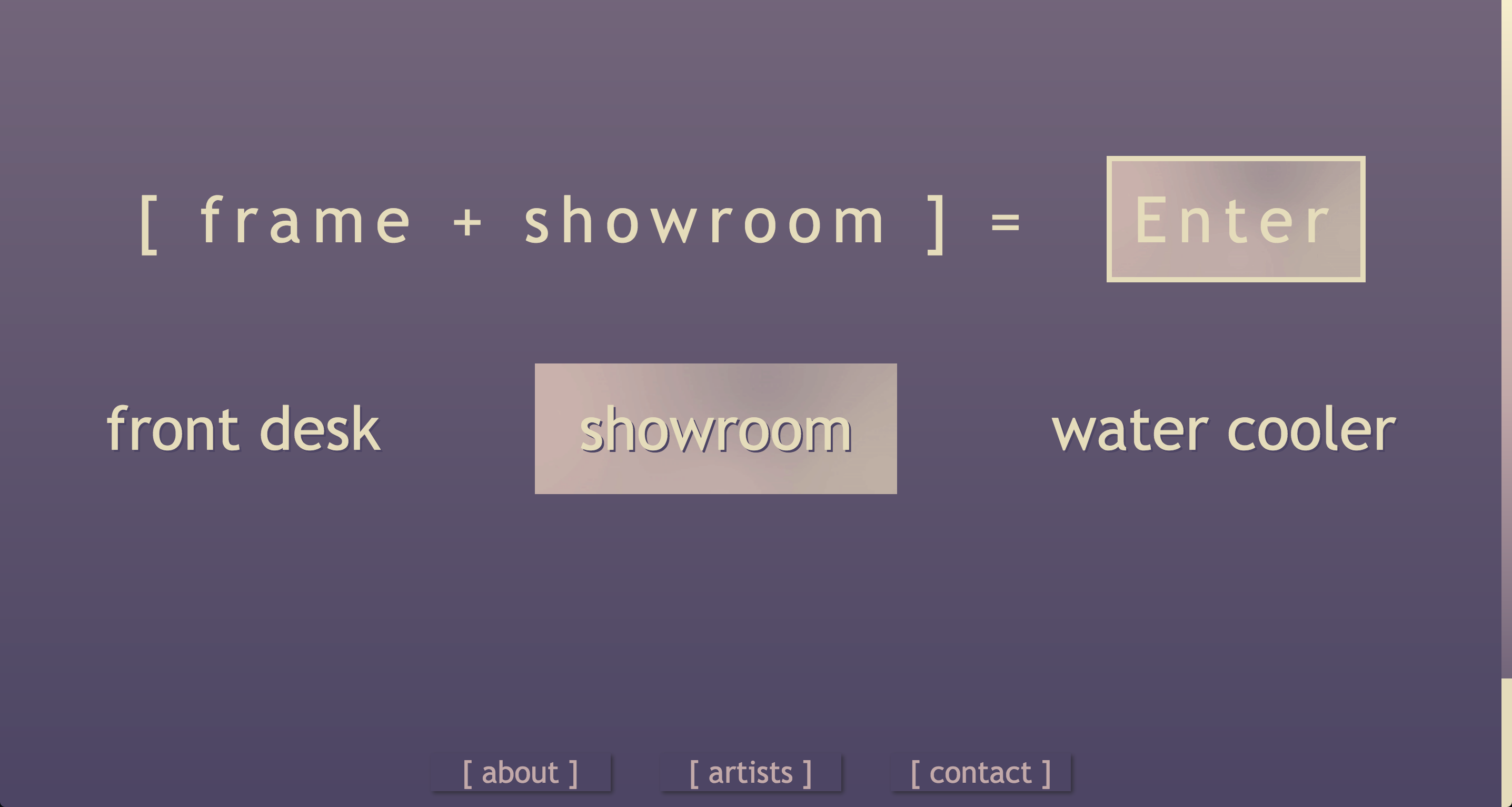
I understand that most of the artists, if not all, had little to no knowledge of coding prior to this project. How was the process of collaborating with them like?
E: As it stands, [ frame + ] is part of an incubator programme we started, SD. We conduct workshops for artists, and teach them how to code. With this group of artists, we started out with a two-day workshop that covered the basics of Javascript, HTML and CSS coding. Throughout this programme, we emphasised to artists the importance of resourcefulness. At the end of the day, we are not programmers. We are artists first, and programmers second. There are many tools available such as Adobe Photoshop or Premiere Pro to create and animate images, so it was very much about making use of what artists themselves already knew, and using these new skills in coding to elevate that knowledge. The nature of coding also lends itself towards sharing. For example, if I wanted to animate an object such that it moved from left to right, I could find an example of this online, and adjust that code for my own purposes.
N: There was a lot of sharing amongst the artists as well. Beside the workshop sessions, we had group discussion sessions where everyone came together to discuss their works. These sessions helped to give us a sense of how everyone was getting on, and also made it easier for us to send relevant or interesting information along to a specific person. We have a rather active group chat where the artists were sharing similar websites or source codes, so that collaborative process really sits quite nicely with their own independent learning. The artists had to go find out how certain things were coded on their own.
E: We also provided artists with, if they needed it, one-on-one technical support sessions. Even from this technical perspective, I feel there is still a strong sense of collaboration. We were suggesting different ways in which artists could approach their ideas, and that affects the eventual output. Denise's work, for example, was first conceptualised to take up the entire screen. However, it wasn't responding to different screen resolutions. From a technical point of view, getting the work to adapt to different screen resolutions was not a straight forward task, so it was much easier to see how the work could be presented in a different way.
For what we say about the Internet being limitless, were there particular things that you guys found limiting about working with it as a medium?
N: Initially, we had this idea where the exhibition would open with a sort of quiz. Depending on how viewers responded, they'd be filtered into a different sort of exhibition experience.
E: We wanted to explore this sort of viewing experience because we were drawing from how Google has been curating what you see online based on the sort of searches you've been doing. So we were drawing upon these ideas of using algorithms to decide what the best user experience would be for a particular viewer.
N: Yeah, eventually it came down to the fact that neither Eugene or I had the expertise to execute something like that. I asked a friend of mine who does programming for her opinion on this idea. She told us that it'd be really difficult, and that we'd need to engage a professional programmer to create a customised solution for us. Even if we succeeded in programming this experience, the file sizes might end up being too big, and crashing our website as well. It just didn't seem practical, so we've shelved that idea for now.
E: Coming back to what you said about the Internet being boundless, I think many of us forget that it is still tied to very physical things. That's why we called the exhibition [ frame + ], because the viewer can never really escape the screen as a frame. It is there, whether or not you acknowledge it.
When we look at webpages, we might think of them as not taking up much or any space at all. However, the reality is that they do take up physical storage space in the hardware.
These aspects do affect our experience of the work itself. Works that are more demanding on your computer's processing abilities would affect whether you experience, for example, lag times. It also affects how quickly the page loads as well. We included the file sizes in every artwork's write up so as to ground the exhibition in that.
⁶ [ frame + ]
Curated by Nicolette Teo and Eugene TYZ
Curated by Nicolette Teo and Eugene TYZ
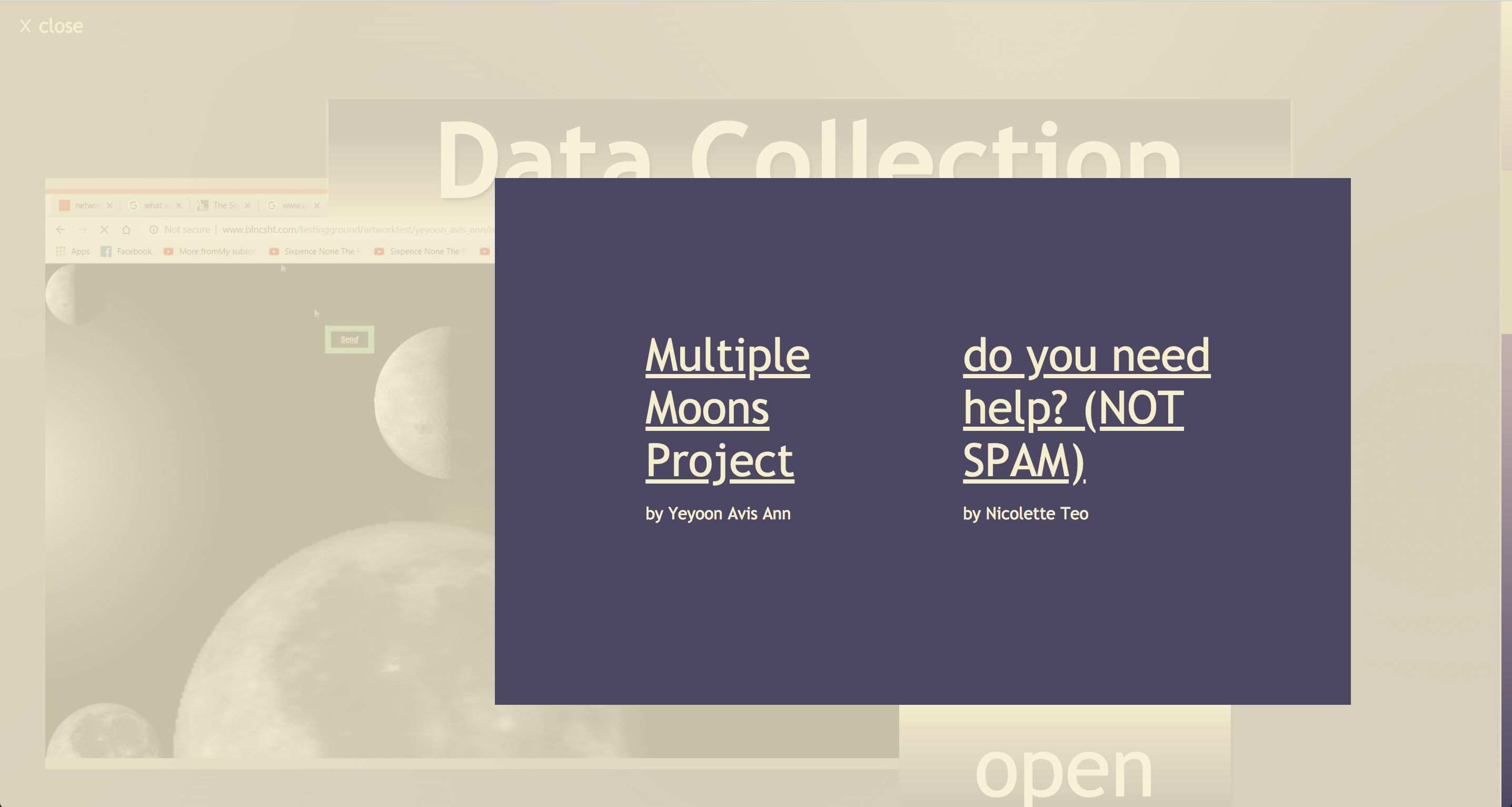
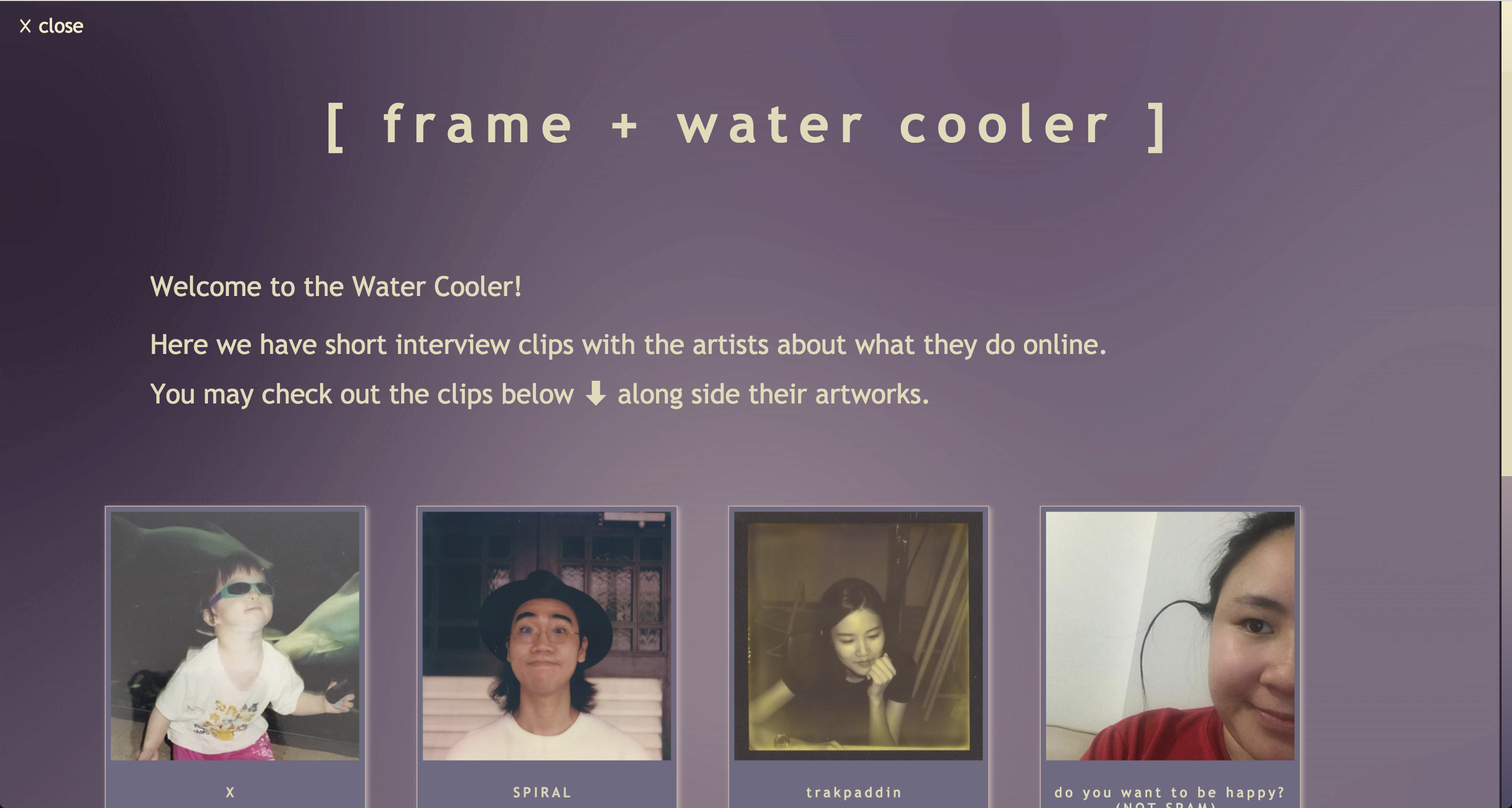
It really stood out to me that you guys included the file size in the various artwork writeups. It is, as you said, about physicality, but it also reminds viewers of the fact that there are various ways in which what you see on screen can be quantified. All of these classifiers have their own significances attached to them, so why did you settle on size as a quantifier?
E: It actually came up because we both thought it'd be quite funny. Most labels have the dimensions of the work and its medium.
N: We were collecting the artworks from the artists, and that was when we noticed the various file sizes. We needed to make sure everything fit into the website, and that nothing was too large. Perhaps that was why it was prominent enough for us to want to include it into the artwork labels.
E: We thought it'd be interesting for viewers would might not really understand the back-end work required in coding a webpage to see that file size as well. Correlating that file size to what they actually are experiencing can be interesting. Some works might seem simple, but take up a lot of space. Others might seem more visually complex, but are more condensed in file size.
N: For those who are familiar with these technicalities, the file size also jumps out at them. We had a viewer ask us how we were running some of these artworks on the page, because some of them were rather large in size.
Viewing art in gallery or institutional spaces can often be quite performative. These spaces often aren't accessible to all, and there is sometimes a pressure to see the artworks in a particular light. Given that [ frame + ] is an exhibition that anyone can view anywhere and anytime, how do you think this exhibition can help reshape how we consume art and approach the physicality of exhibition spaces?
N: Some viewers have told us that they found the exhibition quite fun. It's quite interactive, so the artwork doesn't feel quite as imposing. We really need to gather more feedback, but it's been interesting to see how people interact with it. We set up a Tech Support Lounge in the LASALLE Winstedt Campus for people to come by and view the exhibition. Some viewers have approached them in a manner similar to how they would approach a physical exhibition, and others gloss through the exhibition. In general, there was so much more that we could fit into this exhibition. There was the “Water Cooler" bit, where viewers could listen to the artists speak about their own relationship to the Internet. In a sense, it is more than just an exhibition. It is also a podcast and an informative video.
We wanted to democratise the medium, although we don't mean it in a way where we're evangelicals for this being the next best thing.
We just wanted to provide artists with the tools to experiment with something as familiar to them as the Internet in a new way.
It also would make these artworks accessible to a wider audience, and we hope to continue challenging both artists and viewers with future initiatives and workshops.
E: We've spoken to a couple of viewers who find this experience quite refreshing. Internet or net art has been around for a while, and that was actually one of the reasons why we put this exhibition together. We wondered why nobody around us was really working with the Internet as a medium.
Why do you think artists here aren't working with Internet art as much?
E: We're not too sure. In the 1990's, when Internet art first started gaining momentum, there were a couple of Singaporean artists experimenting with it. That sort of died out a little bit, so what we're trying to do with this project is to get people interested in the potential of the Internet as an art medium. It's quite relevant to how integrated we are today as well.
Let's talk about the “Water Cooler" aspect of the exhibition for a little. It features voice recordings of the various artists speaking about their personal relationship to the Internet. It was such a nice touch, but I wanted to hear from you both as to why you included it into the exhibition. Arguably, it would have still been a strong exhibition without that component.
E: We were thinking of how the viewers experience could be shaped in different ways, and wanted each “room" to provide a different approach to that. With the “Front Desk", we wanted to provide an overview of the artworks from our perspective as curators. The “Showroom" was where the artists took control of framing their own works with their own agendas. With “Water Cooler", we thought that by allowing viewers an insight into the artists' own relationship to the Internet, a new perspective about the artwork could emerge.
N: For Denise, she speaks about gaming in her recording, and this comes through quite strongly when you think about her work. To her, good games are the ones that you can come back to time and time again. That's what she wanted to do with her work as well. We saw these recorded conversations as giving some kind of background or context into the person behind these artworks.
E: You can look at the exhibition as an onion with different layers. The first layer is the works themselves. The second layer is about the image the artists want to project of themselves. The final layer is of the artists as people.
N: We named these different rooms after actual spaces within galleries. We imagined the Front Desk as an area you could go to to pick up a flyer or a leaflet about the exhibition. The Showroom is where you go to see the works themselves. The Water Cooler is where you go to for more informal conversations. This comes back to what Eugene said about relating the Internet space to physical spaces in real life.
⁷ [ frame + ]
Tech Support Lounge Installation View at LASALLE College of the Arts (Winstedt Campus)
Photography by Ng Wu Gang
Tech Support Lounge Installation View at LASALLE College of the Arts (Winstedt Campus)
Photography by Ng Wu Gang

The intersections of art and technology have become hot topics in recent years. What do you both make of these newer developments, particularly with larger tech companies latching onto this in a different, and perhaps more inorganic way, to what you both are doing with SD and [ frame + ]?
E: We haven't really thought outwards in considering these developments. We started SD as our modest approach in getting more people involved with coding and art. We were thinking about this on a relatively small scale. Hopefully with these developments, audiences will become more open to Internet art and Internet art exhibitions.
N: We also hope that these developments will open audiences up to the possibilities these interactions can afford. In comparison to our efforts, larger tech companies have a certain way of working with art and technology. Hopefully by offering a more ground-up or organic approach, we can help viewers come to terms with an alternative way in which art and technology can intersect and meet.
E: Internet art isn't confined to webpages. With the Internet of Things (IoT), there is always this possibility of expanding outwards and larger. Augmented Reality (AR) is also revolutionising how we present or create art.
Many of these larger tech initiatives are touted as having positive cultural impact, or promoting positive cultural values. From your point of view, do you both think that Internet art has to have a positive cultural impact and is that a goal you guys work towards?
N: I wonder what makes something positive. I remember this bot that was created to mimic a millenial's posting habits and language. It was later shut down because it soon began posting racist and inflammatory comments. Do we consider that positive in any way?
E:
Personally, the goal was to make the Internet more fun. We wanted to get artists to imagine and reimagine how you could engage with a website and its content.
It's important to broaden our perspectives of what the Internet could be and how we experience it. Most websites we encounter now are streamlined in terms of design or UI, and we also bounce between using the same few websites. We wanted to have power placed in the hands of people who weren't programmers in the traditional sense of the titles. We used to have blogs where people would have basic knowledge of HTML or CSS coding, but somehow that's been lost as well.
That also comes through in the sort of web hosting services that people gravitate to nowadays. Popular hosting services, such as Squarespace, are proud of the fact that they have pre-set templates for users to choose from and drag-and-drop design functions. The Internet is where you go to be lazy, almost, so that's an interesting paradox for you both to be putting on a show using the online space. With [ frame + ], you're demanding an audience's attention in a space where they're used to being lazy.
N: That laziness shows sometimes. Coming back to what I said earlier about viewers skimming through text, it really was obvious with works such as Eugene's. Viewers were told to pause and wait, but many got impatient and started clicking around. Eventually, the whole page would crash.
E: That is part of the work, because it is how the work retaliates. We often are annoyed by things such as pages lagging or glitching, but these “errors" are embraced in the works and this project.
You've both mentioned the importance of accessibility a couple of times throughout our interview. With Internet artworks, accessibility is definitely important, but do you both feel that we can push our understanding of art and technology towards something more?
E: Things on the internet change over time, and we see this with the interfaces of websites such as Facebook and Youtube. With this particular project, we see [ frame + ] as a space that can evolve over time and this is just one iteration of it because we have the luxury of swapping things in and out of the website easily.
N: We also hope to work on more collaborative efforts to push the Internet as a medium further. We really want to test the limits of a website and what it can do.
⁸ [ frame + ]
Tech Support Lounge Installation View at LASALLE College of the Arts (Winstedt Campus)
Photography by Ng Wu Gang
Tech Support Lounge Installation View at LASALLE College of the Arts (Winstedt Campus)
Photography by Ng Wu Gang
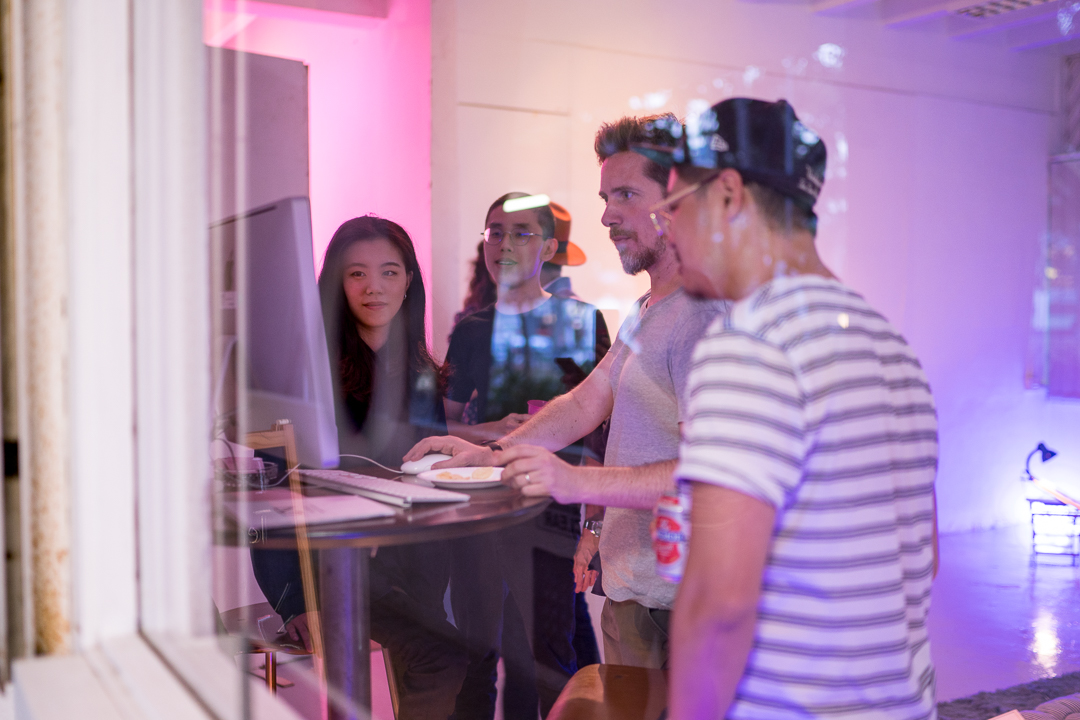

[ frame + ] went live on 15 February 2019.
For more information, view the exhibition online here.
For more information, view the exhibition online here.
